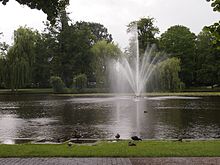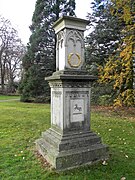French garden (Celle)

The French Garden in Celle is a historical public park in the south of the old town of Celle. It is listed in the register of monuments of the city of Celle and is protected as an architectural monument in accordance with the Lower Saxony Monument Protection Act (NDschG) .
Description of the plant
On the north side, an approximately 330 m long, four-row avenue of lime trees borders the park; it is called Herzogin-Eleonore-Allee. In the south, a mulberry tree avenue forms the boundary of the garden. The Magnus Trench, which is named after Duke Magnus , runs along the far east and south edges . The moat was created in 1370 as part of the city fortifications of Celle . The water is derived from the Aller east of Celle at the "Ziegeninsel" , flows around the southern part of the old town of Celle and flows back into the Aller near the port of Celle. It feeds the large pond in the park and over the city moat as well as the moat of Schloss Celle with water.
The circular pond on the western edge of the park was first depicted in this form in 1770. Before there were four rectangular ponds here. It has a diameter of 95 m, a circumference of around 300 m, a water depth of 80 cm to 1.60 m and a water surface of 7,000 m². There are two old weeping willows on a small island. In the middle of the pond there is a multi-jet fountain that is illuminated in the evening.
In front of the pond there is a self-contained part as a rose garden, the shape of which is reminiscent of the former design as a baroque garden .
In the eastern part of the garden there is the Renaissance castle built in 1611, an open-air stage and the monument to the Danish queen Caroline Mathilde, who was exiled to Celle, from Crottendorfer marble by Adam Friedrich Oeser in 1784 .
The park also includes curved paths, flower beds, large lawns, groups of trees and bushes, sculptures and monuments.
The northernmost part of the park area was partitioned off in 1927. The Institute for Apiculture Celle of the Lower Saxony State Office for Consumer Protection and Food Safety (LAVES) is located here .
history
A pleasure garden already existed here at the beginning of the 17th century . In 1611, Duke Christian had the “little castle” built in the Renaissance style - half-timbered construction. Originally this house was the home of the court gardeners . Today it is used as a day care center.
From 1670, at the instigation of Eleonore d'Olbreuse , the wife of Duke Georg Wilhelm , the French gardener Henri Péronnet († 1690) was commissioned to design the garden. From 1690 to 1701 René Dahuron , also a French, was responsible. The gardens were probably renamed "French Garden" after their country of origin. In the period from 1695 to 1696, the four-row linden avenue was laid out for the first time, which was completely renewed from 1951 to 1953.
From 1713 the horticultural artist Ernst August Charbonnier was employed for the French garden.
The current appearance, no longer that of a French garden , but that of an English landscape park , goes back to Caroline Mathilde , the divorced queen, exiled from Denmark, who lived in Celle from 1772–1775. After her death, the garden was temporarily neglected. So in 1801 the little summer house she had built on the bank of the pond disappeared.
From the middle of the 19th century, under the direction of Court Marshal Carl Ernst von Malortie , the complex was given its present-day appearance based on plans by garden inspector Franz Christian Schaumburg .
At the beginning of the 20th century, the garden inspector Otto von Boehn laid out the rose garden, which was renovated in 1996.
In 1924 a children's playground was built in the east of the site and in 1957 the open-air stage in front of the castle. The elms at Magnusgraben were replaced by maple trees in 1933 . The mulberry tree avenue was replanted in 2002. It is supposed to be a reminder of the mulberry tree plantation originally located south of the park , which was used to raise silkworms .
The garden achieved national fame in 2019 after killing protected moles.
- French garden in Celle
Memorial in memory of the battle of Langensalza
literature
- Celle: The French Garden , Edition 3, ed. from Stadtsparkasse Celle, 1981 (24 pages)
- Rainer Schomann (Ed.), Urs Boeck : French Garden in Celle In: Historical Gardens in Lower Saxony, catalog for the state exhibition, opening on June 9, 2000 in the foyer of the Lower Saxony state parliament in Hanover . Hannover, 2000, pp. 120-121.
Web links
- Website of the city of Celle about the French Garden
- Website of the tourist information about the French Garden
Individual evidence
- ^ Institute for Apiculture
- ↑ Helmut Knocke : Charbonnier. In: Dirk Böttcher , Klaus Mlynek, Waldemar R. Röhrbein, Hugo Thielen : Hannoversches Biographisches Lexikon . From the beginning to the present. Schlütersche, Hannover 2002, ISBN 3-87706-706-9 , p. 84, online via Google books
- ^ Norbert Steinau: Caroline Mathilde in the Electorate of Hanover 1772–1775 . In: Caroline Mathilde. From Copenhagen to Celle - The Short Life of a Queen . Celle 2001, pp. 127-154; P. 135
- ↑ NDR: Celle's controversial fight against the mole. Retrieved March 6, 2019 .
Coordinates: 52 ° 37 ′ 15 ″ N , 10 ° 4 ′ 59 ″ E








